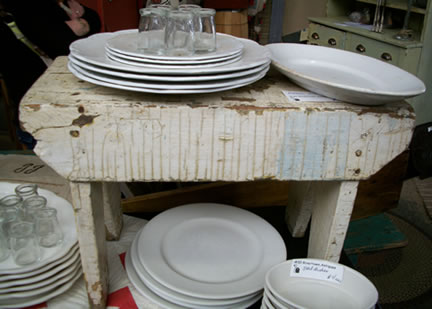Lead
- Lead Home
- Common Sources of Lead
- Contractor Information
- Educational Materials
- Factsheets, Videos and Brochures
- Lead Contractor Search
- Lead Individual License Search
- Lead Licensing
- Health Care Professionals
- Home Owner Information
- Laws and Rules
- Rule Revision: Lead Laws and Rules
- Lead in Schools
- Lead Resources
- Lead Reports
- M-CLEAN
- File a Complaint Related to Lead
- Lead Contacts
Related Sites
- Birth Defects Monitoring and Analysis
- Children's Environmental Health
- DWP Fact Sheets
- Individual and Family Health
- Lead in Well Water
- Nutrition: Healthy Eating
Environmental Health Division
Lead Hazards and Vintage Items
Download a PDF of this information here: Lead Hazards and Vintage Items (PDF)
When furnishing a home or using vintage items, take care to avoid lead poisoning. Building components such as window sashes, doors, and balusters from buildings constructed prior to 1978 may contain lead paint. Other items such as painted tin panels, lead crystal, hardware, jewelry, toys, furniture and dishes may also contain lead. These vintage items may be found at flea markets, garage sales, antique shops and online. Working with or handling lead containing items may produce dust or debris that can be inhaled or ingested and result in lead poisoning.
Why should I be concerned about lead poisoning?
Lead is a toxin. The possible effects of lead poisoning include:
- Delayed mental development, memory and con.ration proble.ms.
- Shortened attention span, aggressive behavior.
- High blood pressure, kidney damage, digestive problems, muscle and joint pain.
- Fertility problems, harm to a developing fetus.
Most individuals with elevated blood lead levels have no symptoms. The only way to tell is to have a blood lead test. Your health care provider can help you decide whether such a test is needed.
What should I do if I own vintage items that contain lead?
Unless you are certain that the item does not contain lead, assume vintage items contain lead and take appropriate precautions to prevent lead poisoning. Do not allow children or pregnant women to come into contact with vintage items assumed or known to contain lead.
Wash hands after working with or handling vintage items.
Do not use vintage dishware or utensils for food service unless you are certain they do not contain lead. Do not use lead crystal for storage of any food or beverage.
Do not dry scrape or sand lead-containing items. Use water to control dust and debris during these activities. Protect your work area and wash with soapy water, followed by rinsing with clean water when the project is complete. Consider the application of a sealant product on finished vintage items to minimize the release of lead dust and debris.
Wear protective clothing that can be discarded or washed separately from other clothing. Consider the use of a half-face respirator with high efficiency particulate air filter (HEPA) filters.
Protect against lead contamination when transporting vintage items. Wrap items in plastic sheeting or otherwise contain to minimize any release of dust and debris.
Testing for the presence of lead may be conducted using an X-Ray Fluorescence device, by submitting a sample to a certified laboratory, or by using lead test kits.
Guidance photographs
The following are pictures of typical vintage items many people buy at flea markets, garage sales, estate sales, online, etc. to use for decoration or restoration. Not all vintage items contain lead paint. However, painted items should be assumed to contain lead paint until they can be tested.
This vintage crib is covered with chipped paint.
These items not only have chipped paint on the hardware, but also on the wood they are attached to.
This small stool has classic alligator skin cracking typical of lead paint.
This old screen door has cracked and chipped paint. Note the post behind it has chipped paint as well.
These decorative metal panels have chipped paint on them.
These decorative metal boxes have chipped paint on them.
These old type-set letters may be made out of lead.
This wicker chair has chipped paint
This decorative wooden panel has cracked and chipped paint on it in the classic alligator skin pattern.